If your smart home devices keep going offline, it’s often due to weak Wi-Fi signals, outdated firmware, or hardware issues with your router. Interference from other electronics or physical obstacles can also disrupt connectivity. Power supply problems and incorrect device settings may contribute too. Improving your Wi-Fi coverage, updating firmware, and checking device configuration can make a big difference. Keep in mind, additional tips can help you troubleshoot and guarantee a more reliable smart home experience.
Key Takeaways
- Weak Wi-Fi signals or poor router placement cause devices to disconnect; boost coverage with extenders or mesh networks.
- Outdated firmware or software can lead to connectivity issues; regularly update device and router firmware.
- Physical barriers like thick walls and metal furniture weaken signals, so optimize device placement for better connectivity.
- Network interference from other electronics or multiple devices sharing bandwidth can disrupt device communication.
- Power supply problems or unstable batteries can cause devices to go offline; ensure proper power sources and replace batteries as needed.
Weak Wi-Fi Signal and Network Range Issues
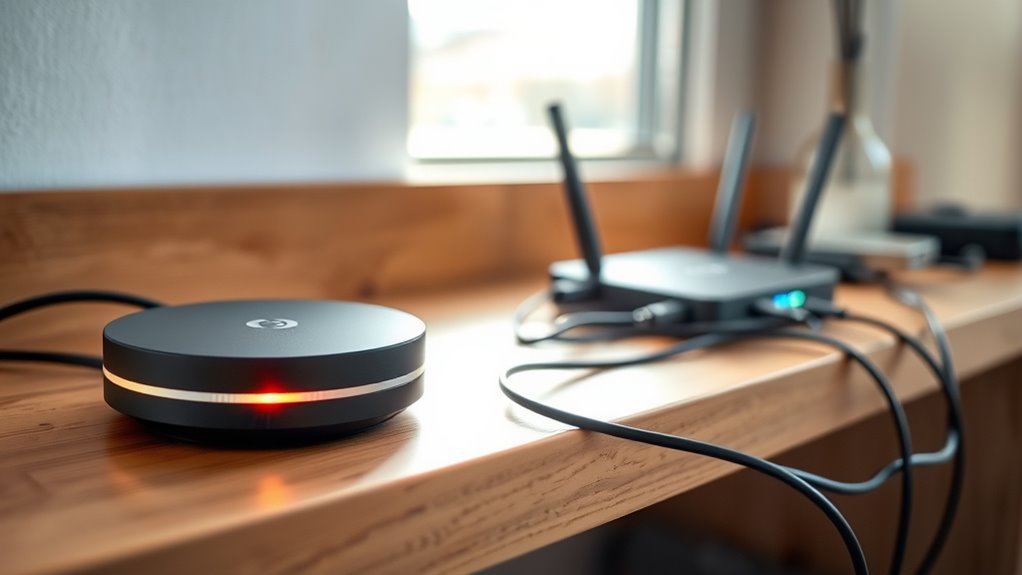
Weak Wi-Fi signals and limited network range are common reasons why your smart home devices go offline. To fix this, consider signal boosting techniques like adding a Wi-Fi extender or mesh network. These devices improve coverage, ensuring your smart gadgets stay connected. Also, evaluate your device placement; placing your router in a central location can substantially enhance signal strength. Avoid placing your router behind furniture or inside cabinets, as obstructions weaken the signal. By strategically positioning your router and boosting signals where needed, you reduce dead zones and improve overall connectivity. Remember, strong, consistent Wi-Fi is essential for your smart home devices to function smoothly, so investing in signal boosting and ideal device placement pays off in better performance and fewer offline moments.
Firmware and Software Outdatedness

If your smart home devices are going offline, outdated firmware and software could be the culprit. Older firmware may not be compatible with new updates or devices, causing connectivity issues. Additionally, delays in software updates mean your devices miss out on important security patches and performance improvements. Regularly checking for software updates can help ensure your devices stay connected and secure.
Firmware Age and Compatibility
Outdated firmware and software can cause smart home devices to disconnect or malfunction unexpectedly. Firmware age plays a vital role in device stability, as older firmware may not support newer network protocols or security standards. Compatibility issues often arise when your device’s firmware isn’t up to date, preventing it from communicating properly with your smart hub or app. This mismatch can lead to frequent disconnects, slow responses, or complete failures. Manufacturers release firmware updates to fix bugs, improve performance, and enhance compatibility with other devices. If your device has outdated firmware, it’s more likely to encounter these issues. Keeping firmware current ensures your devices work seamlessly together, reducing the risk of disconnects caused by compatibility problems and ensuring your smart home runs smoothly. Additionally, fostering a creative practice can help you troubleshoot and adapt to unexpected technical challenges more effectively.
Software Update Delays
Software update delays can considerably impact your smart home devices’ reliability. When updates are postponed or delayed, your devices may not receive essential security patches, bug fixes, or new features, leading to performance issues. Outdated firmware can also cause device compatibility problems, especially if other devices or the central hub have been updated. This mismatch can result in devices going offline or malfunctioning. To prevent this, regularly check for software updates and install them promptly. Keeping firmware up-to-date ensures your devices work seamlessly together and maintain stability. Ignoring update delays risks losing functionality and exposes your network to vulnerabilities. Staying proactive with timely updates helps maintain device compatibility and keeps your smart home running smoothly and securely. Incorporating sound design techniques into your troubleshooting process can also help identify issues with device communication and performance.
Router and Modem Malfunctions
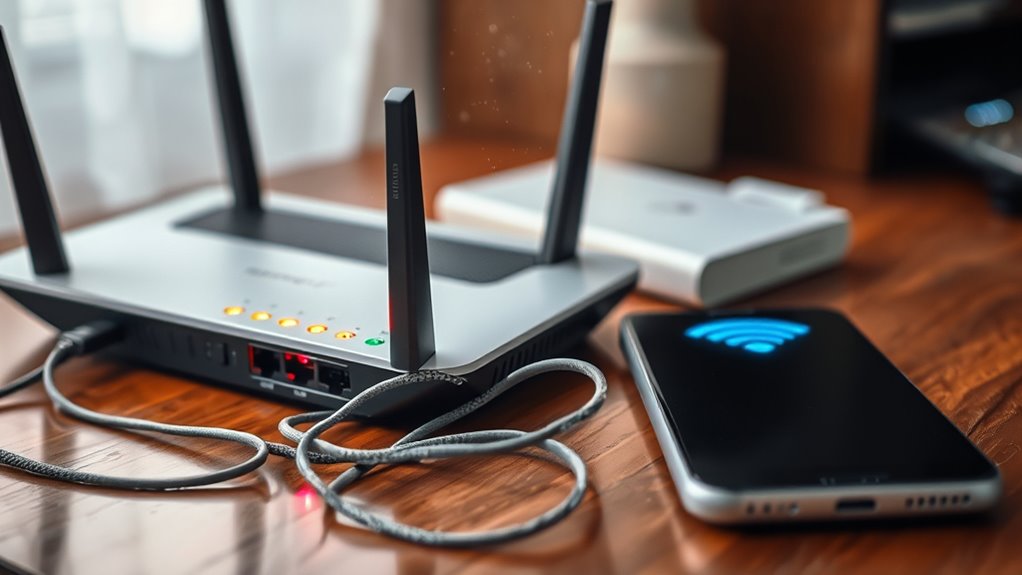
If your smart home devices keep disconnecting, the first step is checking your Wi-Fi signal strength and ensuring your modem is placed ideally. Firmware updates for your router and modem can also fix bugs that cause malfunctions. Proper placement and regular updates can greatly improve connection stability and prevent devices from going offline. Additionally, verifying the router’s hardware specifications can ensure it is capable of handling your network’s demands effectively.
Wi-Fi Signal Strength
Wi-Fi signal strength is essential for maintaining a reliable connection between your smart home devices and your network. Weak signals can cause devices to go offline or behave unpredictably. To improve signal strength, check your router’s placement—avoid walls and obstructions that block wireless signals. Network congestion from multiple devices sharing the same bandwidth can also weaken your connection, so limit unnecessary connections during peak times. Additionally, ensure your Wi-Fi network is secure; poor wireless security can lead to unauthorized users hogging bandwidth, further degrading signal quality. Regularly restarting your router can refresh the connection and reduce interference. Staying informed about data privacy challenges can help you understand potential security risks associated with your network and devices. By maintaining strong Wi-Fi signal strength, you help guarantee your smart home devices stay connected and perform at their best.
Firmware Updates Needed
Outdated firmware on your router or modem can cause malfunctions that disrupt your smart home devices’ connectivity. Firmware stability is essential for consistent performance, but infrequent updates can leave vulnerabilities and bugs unpatched. Regularly checking for firmware updates ensures your devices run smoothly and reduces offline issues. The ideal update frequency depends on your device, but aiming for quarterly checks is a good rule. Below is a table illustrating how update frequency impacts firmware stability:
| Update Frequency | Impact on Firmware Stability |
|---|---|
| Rarely | Increased risk of malfunctions |
| Annually | Moderate risk, possible bugs remain |
| Quarterly | Perfect balance, high firmware stability |
| Monthly | Keeps firmware current, minimal issues |
| As needed | Only when issues arise |
Keeping firmware current minimizes offline problems and improves overall device reliability.
Modem Placement Tips
Proper placement of your modem and router is essential for peak performance and to prevent malfunctions. Start with modem placement by positioning it in a central, open location away from thick walls, metal objects, and electronic devices that cause interference. This ensures a strong, stable signal throughout your home. For ideal router positioning, elevate it off the floor, ideally on a shelf or high surface, and keep it in a central spot to maximize coverage. Avoid placing it near appliances like microwaves or cordless phones, which can disrupt signals. Good modem placement and effective router positioning help reduce dead zones and slowdowns, keeping your smart home devices connected reliably. Adjusting these positions can greatly improve your network’s stability and prevent unnecessary offline issues. Additionally, understanding wireless signal interference can help you identify and eliminate other sources of disruption to maintain a consistent connection.
Interference From Other Devices and Obstacles
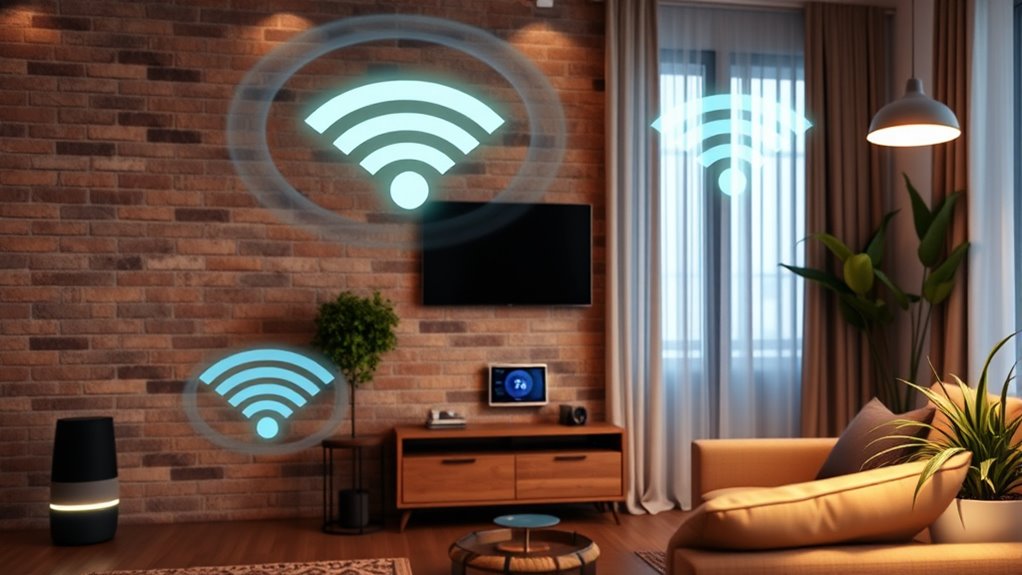
Interference from other devices and physical obstacles can considerably disrupt the connection of your smart home devices. Radio frequency signals can be blocked or weakened by nearby electronics and physical obstructions, causing devices to go offline. Common culprits include cordless phones, microwaves, and wireless speakers operating on similar frequencies. Physical obstructions like thick walls, metal furniture, or appliances can also hinder signal strength, reducing reliability. To improve connectivity:
Interference and obstacles can weaken smart home signals, causing devices to disconnect.
- Minimize the number of electronic devices near your smart home hubs
- Avoid placing devices behind thick walls or large metal objects
- Use a Wi-Fi extender or mesh network to bypass physical barriers
- Incorporating sound vibrations or other environmental factors can also influence signal stability and should be considered when optimizing device placement.
Power Supply Problems and Battery Life
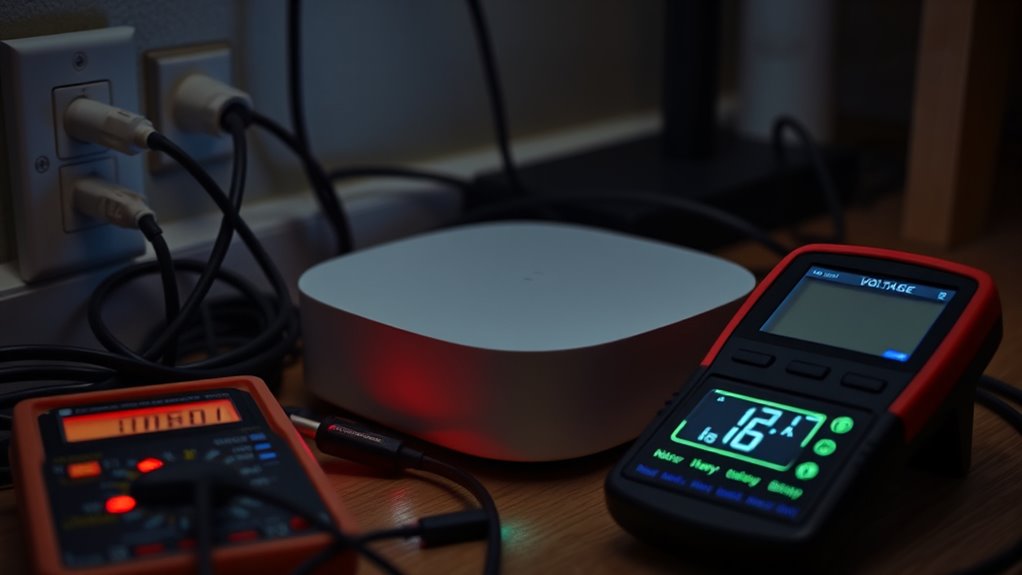
Even if you’ve optimized your device placement to reduce interference, power supply issues can still cause connectivity problems. Devices with low or unstable power sources may shut off unexpectedly or experience intermittent connections. To improve stability, focus on battery optimization by replacing or recharging batteries regularly. If your device is plugged in, ensure the power supply is consistent and the outlet isn’t faulty. Good power management practices, like avoiding power surges and using surge protectors, can prevent disruptions. Keep an eye on battery life indicators and replace batteries before they die completely. Proper power supply maintenance helps keep your smart home devices online, reducing downtime and ensuring reliable performance. Addressing power supply problems is a simple step toward a more dependable smart home setup. Regularly checking power sources and ensuring they are functioning correctly can significantly enhance device stability.
Incorrect Device Configuration and Settings
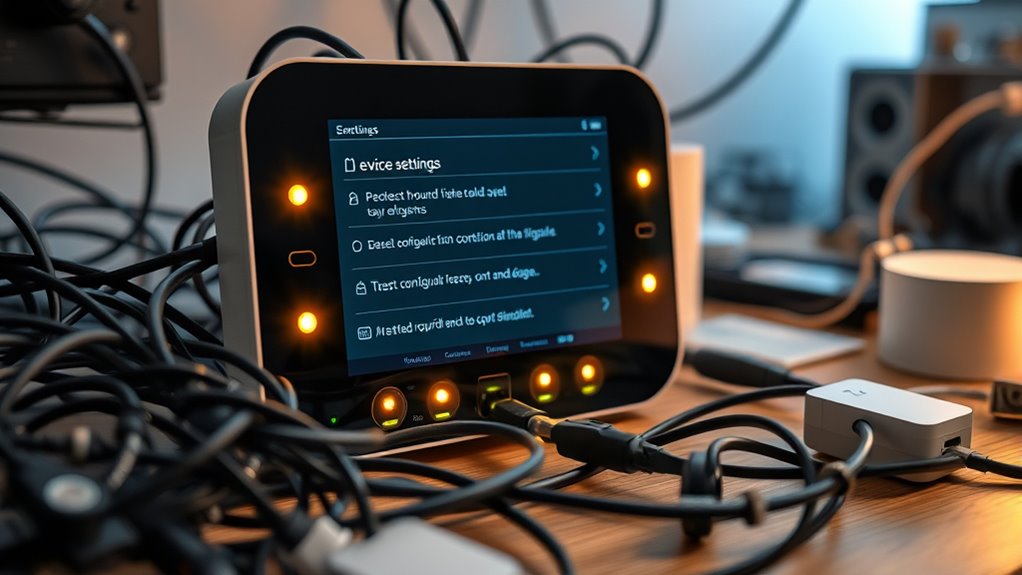
Have you checked if your smart home devices are configured correctly? Incorrect device configuration and settings can cause connectivity issues. First, ensure each device has proper device naming to avoid confusion and easy identification. Next, review your user access controls to prevent unauthorized changes that might disrupt connections. Misconfigured network settings or outdated firmware can also lead to offline devices. To troubleshoot, consider these steps:
Ensure smart devices are properly named, access controls are secure, and firmware is updated to prevent connectivity issues.
- Verify device names are clear and unique
- Confirm user access controls are appropriately set
- Update firmware and reset network settings if needed
- Regularly review configuration best practices to maintain optimal device performance
Proper configuration ensures devices communicate seamlessly with your network. Regularly reviewing these settings helps prevent disconnections and keeps your smart home running smoothly.
Frequently Asked Questions
Can Resetting My Devices Improve Their Online Stability?
Resetting your devices can greatly improve their online stability. When you perform a device reset, it clears temporary glitches and refreshes the connection to your network. This process helps resolve minor software issues and can restore proper communication with your smart home system. Regular resets, especially after firmware updates or connectivity problems, ensure your devices stay reliably connected and function smoothly, enhancing your overall smart home experience.
Do Smart Home Hubs Help Reduce Disconnection Issues?
While some think smart home hubs might add complexity, they actually help reduce disconnection issues. With a hub, your voice command and remote access become more reliable, as it centralizes control and strengthens your network. Instead of multiple devices struggling separately, a hub creates a stable connection, decreasing offline moments. So, investing in a hub can make your smart home more dependable, ensuring your devices stay connected when you need them most.
How Often Should I Update Device Firmware for Optimal Performance?
You should update your smart home device firmware regularly, ideally once a month, to guarantee peak performance. Frequent updates improve device compatibility and fix bugs that could cause disconnections. They also enhance firmware security, protecting your devices from vulnerabilities. By staying current with updates, you guarantee your smart home system remains smooth, secure, and compatible with new features, reducing the likelihood of devices going offline unexpectedly.
Can Changing Wi-Fi Channels Decrease Interference?
Changing your Wi-Fi channel can notably decrease interference, improve connection stability, and boost device performance. When you switch to a less congested Wi-Fi channel, you reduce interference from neighboring networks, streaming devices, and other electronics. This interference reduction helps guarantee your smart home devices stay online, respond faster, and work more reliably. So, if you experience frequent disconnects, experimenting with different Wi-Fi channels could be a simple but effective solution.
What Are Signs of Hardware Failure in Smart Home Devices?
You might notice signs of hardware failure in your smart home devices if they become unresponsive, display error messages, or show inconsistent behavior. To diagnose, perform hardware diagnostics to identify potential issues. Firmware troubleshooting can also help, as outdated or corrupted firmware may cause hardware problems. If these steps don’t resolve the issue, consider replacing the device, as persistent hardware failure often indicates a hardware malfunction.
Conclusion
To keep your smart home running smoothly, think of your network as a delicate dance partner—every step matters. By troubleshooting these common issues, you’re tuning a finely crafted instrument, ensuring it sings in harmony. Don’t let interference or outdated settings silence your smart devices. With a little attention and care, you’ll turn a flickering connection into a steady symphony of seamless automation, making your home truly smart and effortlessly connected.









